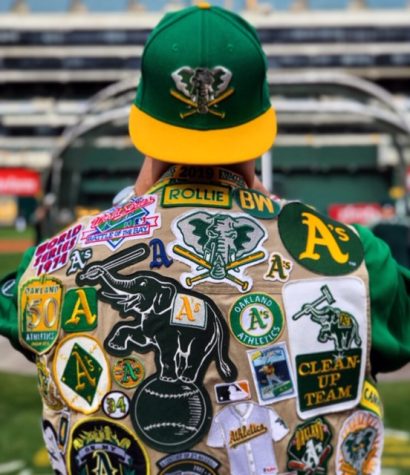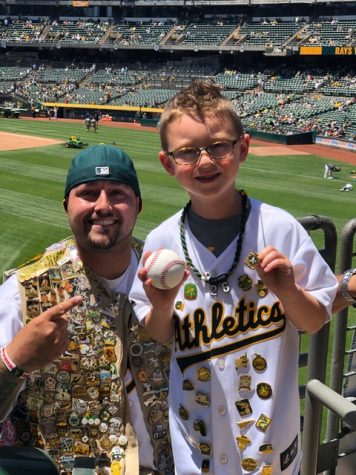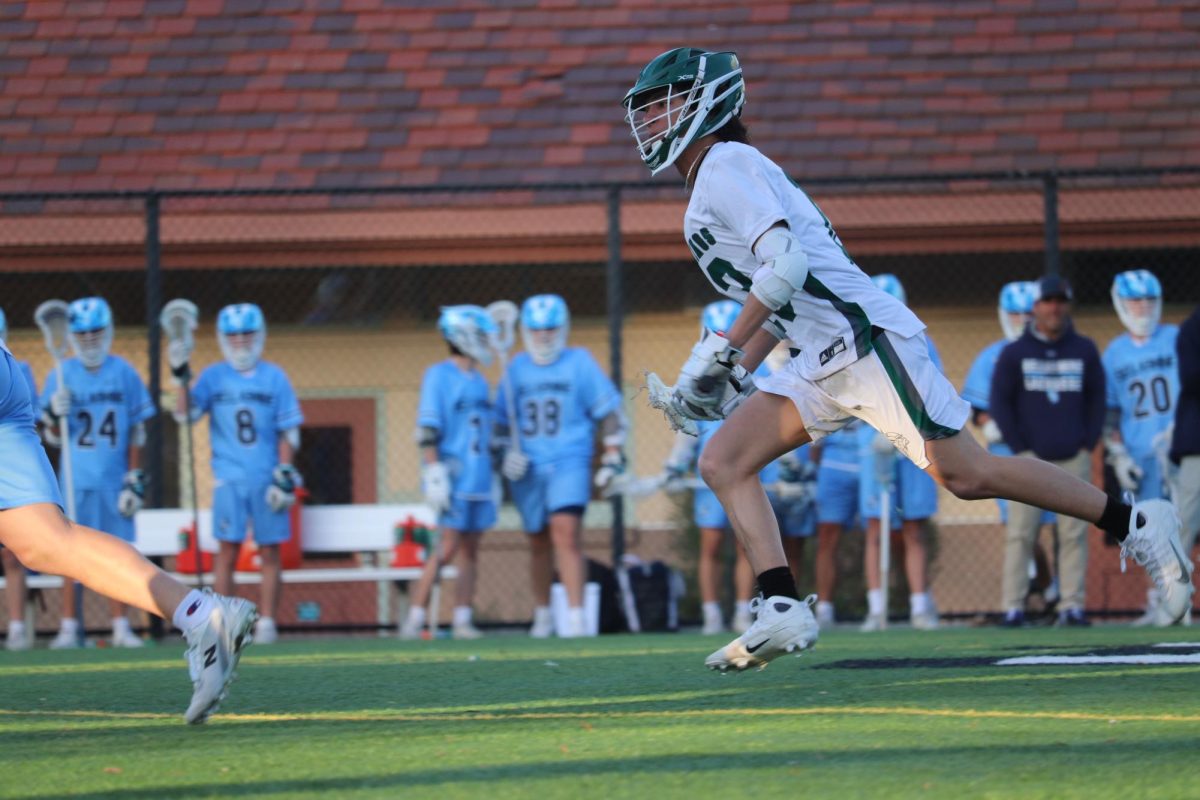From the Stands
From die-hard Oakland superfans to the wild World Cup celebrations in the streets of Paris, countless people around the world show support for their favorite teams. There is no “right way” to be a fan, and as such there is a lot of variation in acts of fandom between people. Let’s take a into the unique world of fandom and some of its wildest examples.
Robin Schreiber is a Warriors superfan who is widely known for dancing wildly on the Warriors’ dance cam.
February 20, 2020
The dominant French national team leads Croatia 4-2 in the final seconds. A desperate last-minute shot from Croatia falls into the arms of French goalkeeper Hugo Lloris. He holds onto the ball tightly, as if his life depends on securing possession. The final whistle is approaching, and France knows that the game is won.
The French people watching from home are on the verge of pure ecstasy, and those who made the trip to Moscow just for the game are on their feet and beginning the celebration. The French sideline is dancing and hugging, and the players on the field are desperately waiting for the referee’s final whistle to join their teammates celebration. The referee checks his watch, puts the whistle to his lips, and blows. The World Cup is over, and France has won.
The bench storms the field and the team forms a mob of exuberant, jumping players. The emotion is overwhelming: utter joy. It is France’s second World Cup, and the long wait––the World Cup is held every four years and France had not won since 1998––makes the victory all the more satisfying.
Just as the team itself, when the final whistle blows, the population explodes. The entire nation seemed to slow to a stop during the World Cup, as many people paused their lives to watch each game. During the final, thousands of citizens crowded the streets, watching live broadcasts and collectively experiencing the highs and lows of the game.
Following the win, happy mobs run through major cities, waving national flags and singing the praises of the winning team. Paris lights up with fireworks as a wave of euphoria sweeps over the nation.
Local high school student Hugo Thomas shared in the celebrations that lasted for weeks following the win. Originally from France, he returned to the country over the summer and experienced a change in the national attitude.
“The spirits were just elevated,” Thomas said. “Everything was increased in terms of good mood. Everyone was way happier than usual.”
The fandom of the French people manifested in their nationalistic pride, celebrating the victory as a unified country.
“Almost everyday you would hear someone going around singing the national anthem and people just wearing French colors and people getting excited about the win,” Thomas said.
The French reaction to victory was not unusual. For many, their own happiness is tied to the success of their sports teams. Just as a championship can bring ecstasy to a city, a defeat can bring despair to loyal fans.
While fans share in their dedication, the origins of their support can vary dramatically.
It is extremely common for people to become fans because their parents had a connection to a team. Exposure to others who support the team will often produce young fans, who, like most children, learn from their parents and begin emulate their behaviors.
This is especially true in the case of national teams, since nationalistic values are engrained in children from a young age.
“Part of [the celebration] was also being patriotic,” Thomas said. “There was an elevated sense of nationalism and happiness being in France.”
The World Cup victory for France was a unifying event for the nation, and people from across the country were able to share in the joy of winning.
It is evident that nationalism is a strong motivator for fandom, and this patriotic pride is reflected in the intensity of the celebration in France.
“The streets when they won were just packed,” Thomas said. “People were taking over public transportation, buses were just getting raided and people were just going in there and moshing. People were getting trampled in Paris.”
Nationalism is such a strong motivator for sports fandom because it is rooted from something intrinsic about a person: their country. Because of this, people can easily connect with each other in support of their country anywhere in the world.
“I was in the US during the World Cup final,” said Thomas. “There were some random French people there wearing Pogba jerseys or Mbappe jerseys, and we met up and started going crazy. So it was really cool to experience patriotism even outside of France. The fact that all the French people were excited about the world cup brought us together. Strangers that I didn’t know; we started getting super hyped up, and that was really reflected in France as well.”
The strength of nationalistic motivations was strongly reflected in the intensity of the celebration of the people. The wild celebrations spread like wildfire, engulfing the nation in euphoria.
“When buses were getting raided and hijacked and people are moshing on them and people are blocking roundabouts and you can’t drive through Paris…You gotta join in,” Thomas said. “It’s not a negative thing. It’s not like it’s a protest. People are doing it because they are so excited. It’s infectious. You can’t resist.”
But nationalistic motivations are not the only driving factor for fandom, there are many fans whose dedication to their teams go beyond their country. Some support their teams despite having no geographic or familial ties.
It is not uncommon for people to become attached to teams for seemingly unimaginable reasons. For dedicated Patriots fan Tom Galetti (‘20), his dedication sprung out of sympathy for the dominant team that had lost its star player and has since developed to a near obsession. On game days, Galetti wears red, white and blue to represent his Patriots as other fans do to show their support. Galetti, however, found himself a fan of the Patriots under unusual circumstances.
“When I was 5, I heard that some random team (the Patriots) went 16-0 and I thought that was so cool,” Galetti said. “They never lost a game. But then I saw that the same team lost the Super Bowl, and then to start off the 2008 season that same team lost its best player in the very first game. I felt so bad for them I said ‘Man, it must be tough to be a fan of that team’ so I started liking them.”
Galetti’s love for the Patriots franchise is evidenced by his closet, as hes known to be sporting team gear after most wins.
For Galetti, the success of his favorite teams—the Patriots and the Univesity of California, Berkeley—is strongly tied to his happiness.
“I definitely feel a lot better after a Patriots (or Cal) win and I feel like my weekend was at least partially wasted when the Patriots lose,” Galetti said.
Galetti’s fandom has more abnormal origins, but there are countless stories of dedicated fans who strongly support their local teams as part of a community of supporters. For most, the question “Why are people fans?” doesn’t change their loyalties. They will still support the teams, buy tickets, wear jerseys, and hope for success. One of the more intricate aspects of fandom is not, though important, why people are fans, but how, and to what extent, they show their support. And if this support crosses into the extreme, why?
The level of dedication can range from casual bandwagon to die-hard, and the actions of some of the most extreme fans—superfans—can cross into the extreme. These extremes cause us to question why we are fans, and what it means to be a fan.
There are some extreme—and often destructive—examples of radical fandom, but superfandom is not limited to short tempers and violence. Superfans can range from people who seek to be unique in their fandom, to those who simply want to have fun expressing their support.
John Silva, known in the Raiders community as “El Cucuy”, which refers to his head-to-toe costume, has witnessed fans so passionate about their teams that they are unwilling to let others express themselves in the same way. He has found that among the community of fans who dress up, some will even become upset when their costumes are replicated by others.
“I had a few friends who dressed up and they would get mad when somebody else would dress up with the same costume that they had,” Silva said. “I told them, ‘Look, if you got it at a store, you can’t not expect someone else to go to the store and buy what you’re wearing.’”
Since he started dressing in costume for Raiders games in 2012, he has made every effort to keep his persona as unique as possible to avoid these confrontations. Before every game, he wakes up hours in advance, shaves his head, and sits patiently while his aunt paints detailed designs on his face and glues spikes to his head. For a 1:00 p.m. game, Silva will wake up as early as 4:00 or 4:30 a.m. to begin the process.
The make-up transformation is so dramatic that opposing and Raiders fans alike are shocked when they see him.
“When I’m out of town and people see it they’re a little more wowed,” Silva said. “Some people are kind of intimidated at first and then they hear me talk and they see my demeanor and they realize that I’m a pretty chill, laid-back person.”
Silva dressing up for Raiders at home is one thing, but when he can, he will even appear in costume to support his team at away games. At times though, logistics impede him from enjoying road games as El Cucuy. To lug his makeup, hefty airbrush, and other materials, Silva adds an entire additional suitcase to his travels making the process far more difficult.
Even more shocking, though, is the camaraderie between dedicated fans that Silva’s process reflects. His aunt—the woman spending three hours on his makeup—isn’t even a Raiders fan. She’s a faithful fan of the Bay Area’s other team, the Forty Niners.
Dressed in what one would expect to be a very intimidating costume, Silva says that his main motivation for continuing with his character is entertaining the kids who attend Raider’s games, kids who are surprisingly unafraid of him.
El Cucuy isn’t the only Oakland superfan. Die-hard A’s fan Brian Johansen—known in the A’s community as “the Kingpin”— has been a season ticket holder since his youth and is a prominent figure in the A’s community due to his famous collection of A’s pins.
When he went to games with his dad as a season ticket holder, he was inspired to collect pins by a couple sitting next to him. He began to collect A’s pins, and would buy as many as he could each game.
“I just got obsessed with it,” Johansen said. “So every time we came to the ballpark, my dad would take me around the concourse and we pretty much buy any pin that they had.”
Johansen thinks of pin collecting as a part of baseball fandom, and views the collection he has amassed over the years as a window into the past.
“This is part of the very fabric of baseball,” Johansen said. “You can have an entire event, you know, encapsulated on one little pin… There’s a lot of historical references that are on each pin.”

Johansen has collected 1100 pins over the years, and wears a fishing vest filled with pins to each game. However, his experience as an A’s superfan goes beyond collecting pins, and he has formed many lasting memories as “the Kingpin”. Last season, he was invited onto the field to meet his favorite player, Ramon Laureano, and got autographed memorabilia.
“They randomly just invited me onto the field,” Johansen said. “They let me, you know, get to meet my favorite player Ramon…they put my name up on the board on the big screen and everything like that so I mean it was pretty cool.”
Johansen remains a fan even despite a decline in the A’s fan community and recent rough patches for the team. He has stuck through difficult times under bad ownership, and after years of decreasing ticket players and limited on-field success, he has confidence that the A’s organization—and the fanbase—are on the rise.
“We’ve had some tough goes at ownership, and so it’s really turned off a lot of fans, but it’s actually getting better with this new management group and this new ownership group,” Johansen said. “It looks like attendance is going to go up.”
In addition to being a loyal fan, he has gone viral on the internet for his fandom. The day after his Ramon Laureano, his favorite player, returned from a stress injury. He was hit by a pitch. The A’s led the league in hit batters, so it was already a sore subject among fans. As soon as Laureano was hit, he jumped up and yelled “WHAT THE F*CK”. The clip went viral, and has become an internet meme.
However, the moment ended up being the basis for community charity work. They used T-shirts joking about the moment to raise money, eventually raising over three thousand dollars.
His fandom has also been a source of inspiration for other fans. In one case, his pin collection inspired a child to take up the hobby.
“There’s a little boy named Mason, and I gave him a bunch of pins and well next thing you know he shows up a couple weeks later, and his entire Jersey is now covered in pins,” Johansen said.

Although somewhat different in her expression of fandom, Robin Schreiber is another fan who is acutely aware of the positive impact their dedication has on others. The famous “Dance Cam Mom” of Oracle Arena, Shreiber is known for dancing wildly on the jumbotron at Warriors games. However, her story goes far deeper than the big screen.
Schreiber has been a fan since her youth and has been a season ticket holder of the Warriors for 39 years with her family. She has remained loyal through the good seasons and the bad ones, from many losing seasons to the dynasty team that dominated in the late 2010s. Despite the recent struggles of the team, she still attends games regularly to show her lasting support.
“If you know anything about the Warriors: most of our time spent at that stadium, it was not a winning team,” Schreiber said. “And when we couldn’t go, we couldn’t even give away the tickets.”
She is a die-hard fan, and visibly expresses her deep commitment to the team. During a game a few years ago, a video of Schreiber dancing wildly for the stadium’s dance cam in a Warriors ugly Christmas sweater went viral and she came to be known to Warrior fans as the “Dance Cam Mom”. The video had over 140 million views on Bleacher Report and over 200 million views on ESPN.
Since the video, she has become a well-known figure in the Warriors community.
“I get recognized in public even [when] I don’t walk around in my warrior sweater but it’s funny” Schreiber said.

She has also emerged as a symbol of die-hard fandom for fellow supporters and gives an example of what it means to be a Warriors fan. Under Armor and Steph Curry partnered to create a custom shoe inspired by Schreiber and her dance cam performances. The shoe features the same design that is seen on the sweater worn by Schreiber at Warriors games.
“They say ‘you’re part of the spirit of the team’,” Schreiber said.
Her big screen dance routine has since become a fixture of home Warriors games, as she usually gets on the jumbotron during the dance cam. But even though she is a superfan like many others, her actions are merely a positive expression of support and not extreme acts of fanaticism.
“We go to sporting events for entertainment, nothing more,” Schreiber said. “It’s not serious. It’s not life and death. It’s just you know, just have fun. I hope it adds to the experience.”
Though sports do impact the personal happiness of many fans less dedicated than Schreiber, she has a very healthy perspective on sports.
“I am not impacted personally, about wins or losses, I enjoy the experience of going to the game,” Schreiber said. “And I think as I mentioned before, I have a good perspective that this is about entertainment.”
The impact of her actions goes beyond the seats at Oracle Arena and the new Chase Center. Because of her fandom and dancing persona, Schreiber has become an important part of the Warriors community, and her media prominence is used to help real-world causes outside of the arena.
“I’ve done close to 60 charitable events,” Schreiber said, “…I really love working with the Boys and Girls Clubs.”
She seeks to continue charitable work—not only as an icon but as a person—in the future.
“I think that’s probably just open the door to there’s a lot of organizations in the Bay Area that need help,” Schreiber said. “And if you have the time, it’s just something that makes you feel good to get back to your community.”
She has also touched many individuals with her fandom. Her video was one of the only sources of laughter for the wife and daughter of a man in critical condition after a motorcycle crash, and when he came to after a coma, it caused him to smile for the first time since the crash. She was even approached by a man from Czechoslovakia, who says he plays her video in a bar and everyone cheers for her.
Her dance-cam enthusiasm has been used to inspire people to better themselves because of her positive attitude and happiness.
“To inspire people to get better, or to be happy in their life is something that’s pretty good,” Schreiber said.
Silva has also had a chance to make an impact on others as El Cucuy. He partnered with the Ronald McDonald House to meet a young girl needing both a kidney and a liver transplant. This, he describes as his favorite fan interaction to date.
“[The girl and her sister] got to go to the Raider game with their mom and their mom messaged me and said ‘Hey, like I know you’re here, is there any way you could come and see us where we are sitting?’” Silva said. “And so by the time I got over there, the little girl was asleep. Then I was like, Oh, and she heard me and she woke up right away and was so excited to see me.”
Because of their actions representing the dedicated fan-bases of their respective franchises, both Schreiber and Silva have both been referred to as “super-fans” but they each have their own take on what that word means, and whether it should rightly be used to describe them.
When asked whether she fit this category, Robin Shreiber responded “Oh, definitely.”
Some, she says, call her a bandwagoner. “I always laugh because—are you kidding me? I am the least bandwagon,” Shreiber said.
Silva, on the other hand, disagrees with the term.
“I think everybody has their own ways of being passionate,” Silva says. “A lot of people consider the people who dress up ‘SuperFans,’ which, I don’t really care for the term very much.”
As someone who dedicates a significant amount of time, energy, and money toward dressing up in support of his team, he understands that others may not have this same ability.
“I don’t think it’s a good title because, to me, everybody’s a fan,” Silva says. “Financial situations might not allow somebody to be representing the way other people do, and I don’t think that’s fair for somebody else to be considered a non-super-fan just because of their situation.”
Fandom is not a concrete term. Whether it be storming the streets in Paris, being violent towards opponents, or dancing happily, people express their support and dedication to their teams in different ways.
All fans have their own reasons to cheer and own ways of doing so. For many, it’s because of the love of the country. Some have personal reasons that others may not understand. Others just love to have fun in the sports world.
Cheer—or don’t cheer—for who you want and be proud of it. In the end, sports can bring people together, build communities, and provide an entertaining outlet for millions of people across the world. Whether you follow sports or not, fandom is an important part of our society. But with this in mind, we must also keep a sense of perspective.
Some of the most extreme actions of radical fandom allow us to take a step back and remember—in the words of Robin Schreiber—”It’s not serious. It’s not life and death. Just have fun.”













